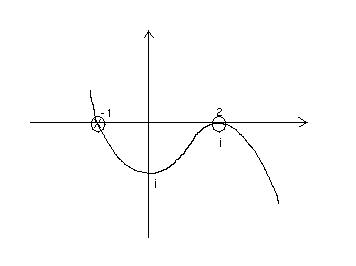M106 Practice Exam 3
[Note: These problems appeared on
my M106 exams in the fall of 1995.]
Instructions: Show all of your work and clearly
explain your answers.
This is particularly important on problems
with a numerical answer, to allow the possibility
of partial credit. No books are allowed
during the exam, but you may use your calculator.
Problem [1] Suppose that f(x) is a differentiable function
such that f(2)=3, f'(2)=5 and f'(3)=7.
- (a) Find dy/dx when x = 2 and y = -1, given that yf(x) + xy3 = -5.
- (b) Find the line tangent to the graph of
y = x7 - 8x2 + 35x - 40 at x = 0.
Answer:
(a) Differentiate the equation:
y'f(x) + yf'(x) + 1y3 + 3xy2y' = 0.
Now plug in x = 2 and y = -1: y'3 + (-1)5 - 1 + 6y' = 0 so y' = 2/3.
(b) y' = 35 and y = -40 when x = 0, so the tangent
line is: y = (35)(x - 0) + -40
Problem [2] Suppose the graph below
gives the derivative g(x) of some function y = G(x).
- (a) Circle each x-value on the x-axis in the graph
for which the original function G(x) has a critical point.
- (b) Put an X (for maX) in each of your critical point
circles for which the critical point is a
local maximum of the original function G(x).
- (c) Put an N (for miN) in each of your critical point
circles for which the critical point is a
local minimum of the original function G(x).
- (d) Put an i at each point of the graph for which the original
function G(x) has a point of inflection.

Problem [3] Consider the
limit as h approaches 0 of [ln(e+h)-1]/h.
- (a) This limit is actually the definition of the derivative of some function
f(x) at some value x = a. Determine f(x) and a.
- (b) Use your answer to (a) to determine the limit exactly.
- (c) Use L'Hopital's rule to determine the limit exactly a second way.
Answer:
(a) This is the derivative of ln x at x = e; i.e., f(x) = ln x, a = e.
(b) Since f(x) = ln x, we know f'(x) = 1/x, so f'(e) = 1/e,
hence the value of the limit is exactly 1/e.
(c) By L'Hopital, the limit as x goes to 0 of [ln(e+x)-1]/x
is the same as the limit as x goes to 0 of [ln(e+x)-1]'/x',
i.e., of [1/(e+x)]/1, which is just [1/(e+0)]/1, or 1/e.
Problem [4] Let h(x) = x2x.
- (a) For what exact x-value is h(x) as small as possible?
Show how you find the correct x-value and how you know
h(x) has a minimum there.
- (b) For what exact x-value or values in the range -3 <= x <= -1
is h(x) as large as possible? Show how you find the
correct x-value and how you know for values in the given range that
h(x) has a maximum there.
Answer:
(a) From the graph of h(x) we expect there to be only one critical point,
between -3 and -1, and that the global minimum of h(x)
occurs there. So we solve h'(x) = 0 to check that there realy is
only one critical point, and to find it exactly. Now
h'(x) = 2x + x(ln 2)2x, and solving
2x + x(ln 2)2x = 0 we get
x = -1/ln 2. So there really is only one critical point,
so from the graph of h(x) that is where h(x) is as small as
possible.
(b) Since the interval -3 <= x <= -1 is closed,
we know that the extrema occur either at the critical point or the endpoints.
We want a maximum, and we know from (a) that the critical point
gives a minimum, so we only need to check h(x) at x = -2 and x = -1.
But h(-3) = -3/8, and h(-1) = -1/2, so the maximum is -3/8,
and it occurs at x = -3.
Problem [5] Farmer Brown wants to fence off three sides of
a rectangular area; the fourth side runs along a river and does not need a fence.
She wants there to be 5000 square yards of land in the rectangle.
What are the dimensions of the rectangle needing the least amount of fencing?
Answer:
(1) The quantity Q to be optimized is the length of fence.
(2) Q = 2w + l, if w is the width of the rectangle and l is the length.
(3) Since lw = 5000, we have l = 5000/w.
(4) Thus Q = 2w + 5000/w.
(5) The range of values of w which make sense here is: w > 0.
(6) From graphing Q(w) on the calculatore we expect that
there is only one citical point and that the minimum occurs there.
We now check this and find that critical point by solving
Q' = 0: Q' = 2 - 5000/w2, so (for w > 0) Q' = 0 occurs
only for w = 50.
(7) The question to be answered is: what are the dimensions of the
rectangle? We now know that w = 50, and l is thus 5000/50 = 100.
